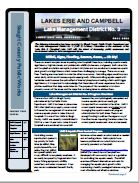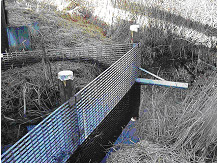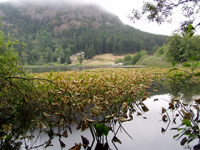LAKES
ERIE & LAKE CAMPBELL (LMD #3)
Lakes Erie & Campbell are located on Fidalgo Island, approximately 3-miles south of Anacortes. Lake Erie is the smaller of the two lakes, totaling 113-acres with a mean depth of 6 ft and maximum depth of 12-feet. Lake Erie drains into Lake Campbell via a half-mile stream. Lake Campbell totals 367-acres in area with a mean depth of 8 ft and a maximum depth of 16-feet. Lake Campbell drains into Similk Bay through an intermittent stream. Both Lakes Erie and Campbell are shallow eutrophic (nutrient rich) lakes and are conducive to excessive aquatic plant growth and algal blooms. The issues impacting the lakes are complicated. There is no easy solution, making them a challenge to manage. Treating one issue tends to make the other issue worse.
In 2001, the majority of Lake Erie and Campbell waterfront property owners voted to establish Lake Management District No. 3 (LMD 3) and charge themselves annual special assessments for the management of aquatic weed growth in both lakes. LMD3 was recently re-established in 2020 for another 10-year duration. The primary goal of the District is to eradicate or control invasive aquatic plants like Eurasian watermilfoil (Myriophyllum spicatum) using the methods identified in the Integrated Aquatic Plant Management Plan (IAPMP) for Lakes Erie/Campbell. The native aquatic plant population has also become problematic around docks and swimming areas at Lake Erie which occasionally warrants seasonal control.
Algae management is not currently financed under the LMD3 program due to the high costs associated with it and because algal blooms are typically short-lived. Nutrients, primarily phosphorus, are the key ingredients that can trigger excessive algae growth or algal blooms. Most algae are not harmful but can sometimes create undesirable water quality conditions that can last for several days. Blue-green algae (also called cyanobacteria) are a type of bacteria that have similar qualities to algae that can sometimes produce harmful toxins or deplete oxygen and cause fish kills. Blue green algal blooms often look like spilled green paint floating on the water. Swirls of blue and white and a foul smell will often occur as the algae starts to decay. If you are unsure whether or not an algal bloom is toxic, a good rule of thumb is just to avoid contact with the water during a bloom. If a potential toxic algal bloom is suspected, contact the Skagit County Health Department. Lab tests are the only way to confirm if there are any toxins present.
For more information about toxic algal blooms:
Lake Erie and Lake Campbell Reports [Pdf]:
2002 | 2003 | 2004 | 2005 | 2006 | 2007 | 2008 | 2009 | 2010 | 2011 | 2012 | 2013 | 2014 |
2015 | 2016 | 2017 | 2018 | 2019 | 2020 | 2021 | 2022 | 2024
IAVMP Report
2024 Lake Cyanobacteria Management Plan
2024 Lake Campbell Sediment Incubation Study Report | Study Slides
In addition to aquatic weeds and algal blooms, Lake Campbell has had a long history of elevated lake levels and drainage concerns during heavy rain events. The County’s Drainage Utility retained an engineering firm to investigate the Lake Campbell outlet and released a Technical Memorandum summarizing the findings that can be found here.
For information regarding recreational water safety and algae blooms, please visit our Skagit County Environmental Health Recreational Water Safety web page or check out the WA State Toxic Algae web page.
For more
information about aquatic plant management and LMDs, please
contact:
Evan Emrick
Noxious Weed Technician- Safety Committee Representative- PW
(360) 416-1465
Skagit County Public Works, Natural Resources Division
evane@co.skagit.wa.us |






